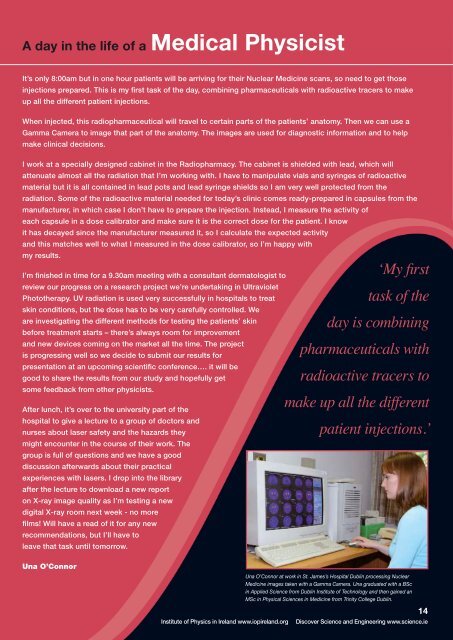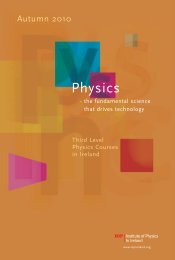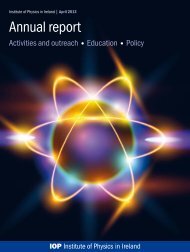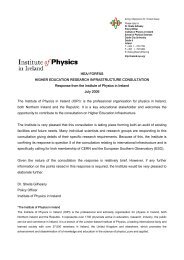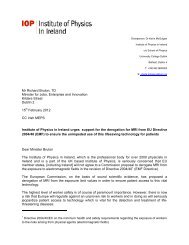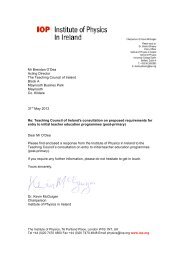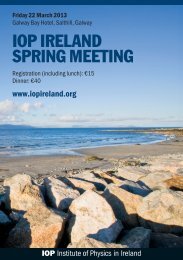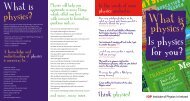28 Days 28 Physicists - The Institute of Physics in Ireland
28 Days 28 Physicists - The Institute of Physics in Ireland
28 Days 28 Physicists - The Institute of Physics in Ireland
Create successful ePaper yourself
Turn your PDF publications into a flip-book with our unique Google optimized e-Paper software.
A day <strong>in</strong> the life <strong>of</strong> a Medical Physicist<br />
It’s only 8:00am but <strong>in</strong> one hour patients will be arriv<strong>in</strong>g for their Nuclear Medic<strong>in</strong>e scans, so need to get those<br />
<strong>in</strong>jections prepared. This is my first task <strong>of</strong> the day, comb<strong>in</strong><strong>in</strong>g pharmaceuticals with radioactive tracers to make<br />
up all the different patient <strong>in</strong>jections.<br />
When <strong>in</strong>jected, this radiopharmaceutical will travel to certa<strong>in</strong> parts <strong>of</strong> the patients’ anatomy. <strong>The</strong>n we can use a<br />
Gamma Camera to image that part <strong>of</strong> the anatomy. <strong>The</strong> images are used for diagnostic <strong>in</strong>formation and to help<br />
make cl<strong>in</strong>ical decisions.<br />
I work at a specially designed cab<strong>in</strong>et <strong>in</strong> the Radiopharmacy. <strong>The</strong> cab<strong>in</strong>et is shielded with lead, which will<br />
attenuate almost all the radiation that I’m work<strong>in</strong>g with. I have to manipulate vials and syr<strong>in</strong>ges <strong>of</strong> radioactive<br />
material but it is all conta<strong>in</strong>ed <strong>in</strong> lead pots and lead syr<strong>in</strong>ge shields so I am very well protected from the<br />
radiation. Some <strong>of</strong> the radioactive material needed for today’s cl<strong>in</strong>ic comes ready-prepared <strong>in</strong> capsules from the<br />
manufacturer, <strong>in</strong> which case I don’t have to prepare the <strong>in</strong>jection. Instead, I measure the activity <strong>of</strong><br />
each capsule <strong>in</strong> a dose calibrator and make sure it is the correct dose for the patient. I know<br />
it has decayed s<strong>in</strong>ce the manufacturer measured it, so I calculate the expected activity<br />
and this matches well to what I measured <strong>in</strong> the dose calibrator, so I’m happy with<br />
my results.<br />
I’m f<strong>in</strong>ished <strong>in</strong> time for a 9.30am meet<strong>in</strong>g with a consultant dermatologist to<br />
review our progress on a research project we’re undertak<strong>in</strong>g <strong>in</strong> Ultraviolet<br />
Phototherapy. UV radiation is used very successfully <strong>in</strong> hospitals to treat<br />
sk<strong>in</strong> conditions, but the dose has to be very carefully controlled. We<br />
are <strong>in</strong>vestigat<strong>in</strong>g the different methods for test<strong>in</strong>g the patients’ sk<strong>in</strong><br />
before treatment starts – there’s always room for improvement<br />
and new devices com<strong>in</strong>g on the market all the time. <strong>The</strong> project<br />
is progress<strong>in</strong>g well so we decide to submit our results for<br />
presentation at an upcom<strong>in</strong>g scientific conference…. it will be<br />
good to share the results from our study and hopefully get<br />
some feedback from other physicists.<br />
After lunch, it’s over to the university part <strong>of</strong> the<br />
hospital to give a lecture to a group <strong>of</strong> doctors and<br />
nurses about laser safety and the hazards they<br />
might encounter <strong>in</strong> the course <strong>of</strong> their work. <strong>The</strong><br />
group is full <strong>of</strong> questions and we have a good<br />
discussion afterwards about their practical<br />
experiences with lasers. I drop <strong>in</strong>to the library<br />
after the lecture to download a new report<br />
on X-ray image quality as I’m test<strong>in</strong>g a new<br />
digital X-ray room next week - no more<br />
films! Will have a read <strong>of</strong> it for any new<br />
recommendations, but I’ll have to<br />
leave that task until tomorrow.<br />
‘My first<br />
task <strong>of</strong> the<br />
day is comb<strong>in</strong><strong>in</strong>g<br />
pharmaceuticals with<br />
radioactive tracers to<br />
make up all the different<br />
patient <strong>in</strong>jections.’<br />
Una O’Connor<br />
<strong>Institute</strong> <strong>of</strong> <strong>Physics</strong> <strong>in</strong> <strong>Ireland</strong> www.iopireland.org<br />
Una O’Connor at work <strong>in</strong> St. James’s Hospital Dubl<strong>in</strong> process<strong>in</strong>g Nuclear<br />
Medic<strong>in</strong>e images taken with a Gamma Camera. Una graduated with a BSc<br />
<strong>in</strong> Applied Science from Dubl<strong>in</strong> <strong>Institute</strong> <strong>of</strong> Technology and then ga<strong>in</strong>ed an<br />
MSc <strong>in</strong> Physical Sciences <strong>in</strong> Medic<strong>in</strong>e from Tr<strong>in</strong>ity College Dubl<strong>in</strong>.<br />
14<br />
Discover Science and Eng<strong>in</strong>eer<strong>in</strong>g www.science.ie


